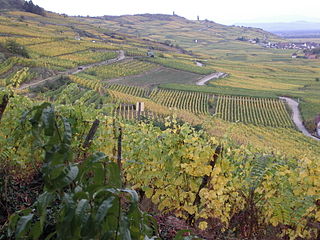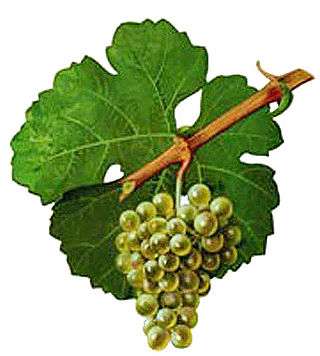
Burgundy wine is made in the Burgundy region of eastern France, in the valleys and slopes west of the Saône, a tributary of the Rhône. The most famous wines produced here, and those commonly referred to as "Burgundies", are dry red wines made from pinot noir grapes and white wines made from chardonnay grapes.
Biodynamic wines are wines made employing the biodynamic methods both to grow the fruit and during the post-harvest processing. Biodynamic wine production uses organic farming methods while also employing soil supplements prepared according to Rudolf Steiner's formulas, following a planting calendar that depends upon astrological configurations, and treating the earth as "a living and receptive organism."

Alsace wine or Alsatian wine is produced in the Alsace region in France and is primarily white wine. Because of its Germanic influence, it is the only Appellation d'Origine Contrôlée region in France to produce mostly varietal wines, typically from similar grape varieties to those used in German wine. Along with Austria and Germany, it produces some of the most noted dry Rieslings in the world as well as highly aromatic Gewürztraminer wines. Wines are produced under three different AOCs: Alsace AOC for white, rosé and red wines, Alsace Grand Cru AOC for white wines from certain classified vineyards and Crémant d'Alsace AOC for sparkling wines. Both dry and sweet white wines are produced.

Alsace Grand Cru is an Appellation d'Origine Contrôlée for wines made in specific parcels of the Alsace wine region of France. The Grand Cru AOC was recognized in 1975 by the INAO with subsequent expansion in 1983, 1992 and 2007.

Silvaner or Sylvaner is a variety of white wine grape grown primarily in Alsace and Germany, where its official name is Grüner Silvaner. While the Alsatian versions have primarily been considered simpler wines, it was included among the varieties that can be used to produce Alsace Grand Cru wine in 2006, together with the four 'noble grapes' of Alsace, although only in one vineyard, Zotzenberg.
Château Lascombes is a winery in the Margaux appellation of the Bordeaux region of France. The wine produced here was classified as one of fifteen Seconds Crus in the original Bordeaux Wine Official Classification of 1855. In the 1950s, the estate was purchased by French wine writer Alexis Lichine who continued to own part of the estate till 1971 when Bass Charrington took over principal ownership. In 2001 it was purchased by Yves Vatelot and US-based Colony Capital, who in 2011 sold it to the French insurance group MACSF. In addition to its premier cuvee, a second wine is also produced, under the name Chevalier de Lascombes. Additional brands are Château Segonnes, Rosé de Lascombes, Vin Sec Chevalier de Lascombes and Gombaud.
The glossary of wine terms lists the definitions of many general terms used within the wine industry. For terms specific to viticulture, winemaking, grape varieties, and wine tasting, see the topic specific list in the "See also" section below.

Château la Mission Haut-Brion is a Bordeaux wine from the Pessac-Léognan appellation, classed among the Crus Classés in the Graves classification of 1953. La Mission Haut-Brion is the sister property of the First Growth Château Haut-Brion. The winery, located in close vicinity of the city of Bordeaux, belongs to the wine region Graves, in the commune of Talence with additional property in Pessac.
Château La Tour Haut-Brion was a Bordeaux wine estate from the Pessac-Léognan appellation within Graves, and was ranked as a Cru Classé for red wine in the Classification of Graves wine of 1953 and 1959. It was located in close vicinity of the city of Bordeaux, in the commune of Talence, adjoining Château La Mission Haut-Brion.

Provence (Provençal) wine comes from the French wine-producing region of Provence in southeast France. The Romans called the area provincia nostra, giving the region its name. Just south of the Alps, it was the first Roman province outside Italy.
Mas Cal Demoura is a wine domaine situated near the village of Jonquières in the Terrasses du Larzac appellation in the north of the Hérault region, Southern France.
The Alsace Grand Cru Hengst, or Hengst, is a French wine originating in the commune of Wintzenheim, in the département of Haut-Rhin, in Alsace. While historically almost solely made up by white wines, a small amount of production is now Grand Cru red wine, solely from Pinot Noir grapes.

Alsace Grand Cru Altenberg de Bergheim, or Altenberg-de-Bergheim is a French white wine produced in the Altenberg lieu-dit, located in the commune of Bergheim, in the Haut-Rhin department, in Alsace.

Alsace Grand Cru Altenberg de Wolxheim, or altenberg-de-wolxheim is a French white wine produced in the Altenberg lieu-dit, located in the commune of Wolxheim, in the Haut-Rhin department, in Alsace.

Alsace Grand Cru Brand is a French white wine produced in the Haut-Rhin department, in Alsace.

Bruderthal is an Alsace Grand Cru French white wine from the village of Molsheim produced in the Bas-Rhin department, in Alsace.

Alsace Grand Cru Eichberg is a French white wine produced in the Haut-Rhin department, in Alsace. On the Alsace Wine Route, Eichberg is located six kilometres southwest of Colmar. In terms of the Alsace vineyards it lies between Pfersigberg to the north and Hatschbourg to the south. It is one of the fifty-one grands crus of the Alsace region, each enjoying its own appellation but sharing the same Alsace Grand Cru specifications.
Alsace Grand Cru ‘’Engelberg’’ is a French white wine produced in the Bas-Rhin department, in Alsace.

Alsace Grand Cru Floriment is a French white wine produced in the Haut-Rhin department, in Alsace. It is a part of the communes of Ingersheim and Katzenthal.

Evelyne de Pontbriand was a French winemaker and the proprietor of Domaine du Closel – Château des Vaults, a winery in the Savennières appellation of the Loire Valley. She managed the estate from 2001, implementing biodynamic viticulture practices and advocating for the Chenin Blanc grape through initiatives such as the Académie du Chenin and the Chenin Blanc International Congress.










